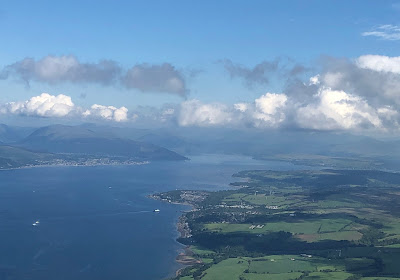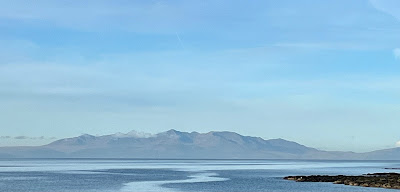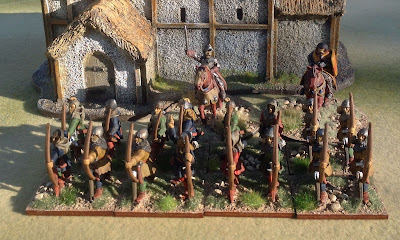This is Colin Turbett's new book on Arran and the Firth of Clyde in the Second World War. A local history of the coast I live on.
For those unfamiliar with the area, the waterway leads to the River Clyde and the city of Glasgow. The region was pivotal in WW2, providing a seaport safer from the Luftwaffe than those further south. 500 million tons of shipping moved into and out of Glasgow, bringing cargo and troops from the USA. The Clyde shipyards also built 1,903 naval and merchant ships and converted a further 637 for wartime uses.
Dominating the Firth of Clyde is the Island of Arran, often described as Scotland in miniature. It was a crisp winter day when I took this picture on my bike ride this morning.
Colin describes the many naval and air bases established along the coasts to protect the Clyde during wartime. These included a boom defence at the entrance to the Clyde near Gourock, consisting of a steel net defended by Boom Defence Vessels and shore batteries. If you travel to Arran today, it will be by ferry from Ardrossan. In WW2, this was a base for minesweeping and anti-submarine patrols called HMS Fortitude. There were subsidiary facilities in my town of Troon. Also near me is Prestwick Airport, a vital air bridge with 38,000 aircraft coming in from the USA. It was supported by an airfield at Dundonald, which, although closed, still has a few buildings standing.
 |
| The Firth of Clyde taken by me from a friend's plane based at Prestwick Airport. |
Arran was a training base for Commandos until they moved up to the Highlands in 1942. Specifically, 9 and 11 Commando were based on the island. Colin tells the stories of the island during wartime and the service men and women who made it their home. He also lists the substantial loss of life from aircraft crashes and sinkings. Of the 15 ships lost, only one was caused directly by enemy action, although enemy mine laying was a problem. It is often forgotten how high the accident rate was on training flights when the safety standards were much lower than today's. He also tells the story of the sinking of U-33 by HMS Gleaner. Divers recovered parts of an Enigma coding machine that contributed to cracking the German coding system.
This is a fine history of one community during wartime. I would also draw attention to a short booklet by Colin's son, Liam, Island Brigaders. This tells the story of local men Robert Milton and William Bamborough, who volunteered to fight in Spain, defending democracy as part of the broader struggle against fascism. Milton was a machine gunner in the International Brigades. Bamborough was a pilot who flew in the Republican Air Force. Well worth a read.
























